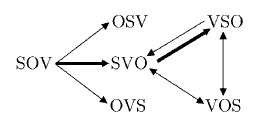October 12, 2011 report
Noted physicist teams with anthropologist to create ancient linguistic tree

(PhysOrg.com) -- With the thousands of languages in the world today, it’s hard to imagine just one of them being spoken by all of the existing humans on Earth. And while there is really no way to prove that such was the case some fifty thousand years ago when the human race apparently shifted into behavior patterns that are more consistent with modern behavior than that which had come before, many believe it to be the case.
It was during this time period that early humans began to use more sophisticated tools, to paint and to create engravings and sculpture. Many historians have attributed this “sudden” leap to the development of language. And if that was the case, then it’s likely all the people of that time were all speaking the same language, seeing as how there were still so few of them.
Now, well-known physicist Murray Gell-Mann and anthropologist Merritt Ruhlen argue that most languages descended from a common ancestor which likely came much later as the result of a possible bottleneck.
They describe in their paper published in the Proceedings of the National Academy of Sciences, how they believe that rather than following the more modern language construct of subject-verb-object (SVO), the ancient base language instead used subject-object-verb (SOV), such as is the case with old so-called dead languages, like Latin.
Murray Gell-Mann, currently a distinguished fellow with the Santa Fe Institute in New Mexico, received the Nobel Prize in Physics back in the late sixties for work he did on the theory of elementary particles. In addition to his numerous achievements in the field of physics, Gell-Mann has apparently always had an interest in linguistics as well. Now in his eighties, he has embarked on what some may deem a controversial idea; to develop a linguistics tree going all the way back to the first human language.
Thus far he and partner Ruhlen have come up with some 2200 nodes comprised of eight distinct branches, and twenty two sub or sub-sub branches. For each branch or sub, the two describe its most modern state and then work backwards to show how it might have developed from an older form. Using this method to go all the way back in time to the single earlier language, the two propose it must have been of the subject-object-verb variety.
It should be noted that thus far, the work is still just theory, and not all historians or linguistics experts for that matter, agree on its validity.
More information: The origin and evolution of word order, PNAS, Published online before print October 10, 2011, doi:10.1073/pnas.1113716108
Abstract
Recent work in comparative linguistics suggests that all, or almost all, attested human languages may derive from a single earlier language. If that is so, then this language—like nearly all extant languages—most likely had a basic ordering of the subject (S), verb (V), and object (O) in a declarative sentence of the type “the man (S) killed (V) the bear (O).” When one compares the distribution of the existing structural types with the putative phylogenetic tree of human languages, four conclusions may be drawn. (i) The word order in the ancestral language was SOV. (ii) Except for cases of diffusion, the direction of syntactic change, when it occurs, has been for the most part SOV > SVO and, beyond that, SVO > VSO/VOS with a subsequent reversion to SVO occurring occasionally. Reversion to SOV occurs only through diffusion. (iii) Diffusion, although important, is not the dominant process in the evolution of word order. (iv) The two extremely rare word orders (OVS and OSV) derive directly from SOV.
© 2011 PhysOrg.com



















